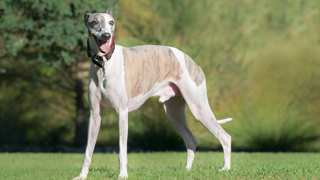Whippet Breed Details
Whippets are classified as sight hounds and have made names for themselves in the lure coursing and racing arenas as well; note, lure coursing is a humane replacement of the hare coursing for which they were renowned. There are many other desirable aspects of Whippets besides speed and hunting abilities; they are loving, affectionate companions that will always want to be in your lap, next to you or, at least, near you. They are excellent indoor dogs for families or individuals that have a house with a nice yard; if you are gone more frequently than you're at home, this is NOT the dog for you. Their low percentage of body fat makes them averse to cold temperatures and hard surfaces so if you don't want to share your home, furniture and bed with one--this is also NOT the breed for you. Whippets are not dangerous unless you happen to be a small, furry creature resembling a rabbit (yes, this includes cats). Here are some quick Whippet facts (pros and problems) to see how you match up with this breed:
PROS
- Makes an affectionate friend for gentle, well-behaved kids
- Affectionate, loving, will want to be with you 24/7
- Calm indoors, energetic outdoors
- Eye-catching looks
- Excels in sight hunting activities
- Speedy racing and coursing hound
- Great exercise buddy
- Lives well with other dogs
- Is not aggressive towards strangers
- Low maintenance grooming
- Fairly healthy and long-lived breed
CONS
- Not a watchdog or guard dog
- Not hypoallergenic, sheds regularly
- Does better in a home than apartment
- Cannot tolerate extremely cold temperatures
- Prefers to lounge on the bed and furniture
- Large yard highly recommended
- Daily outdoor exercise required (of an hour or more)
- Prone to separation anxiety, excessive greeting
- Not for owners who don't spend much time at home
- A Bully Whippet with two copies of the Myostatin mutated gene will be grotesquely muscles and unable to compete in club organized activities; this often causes no physical harm to them, though.






















